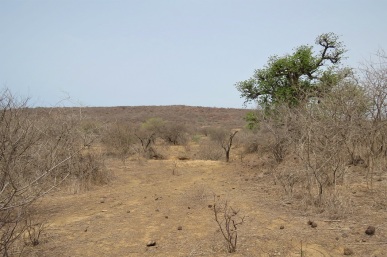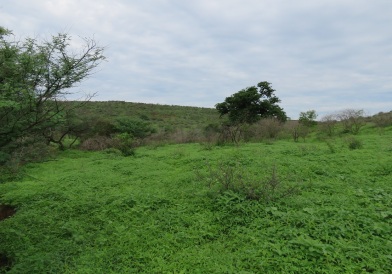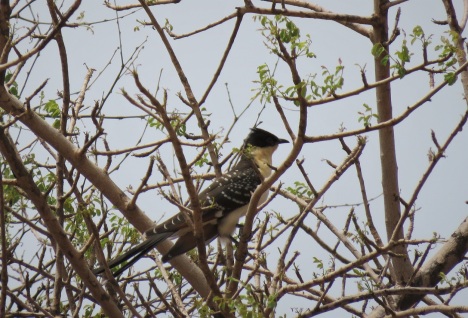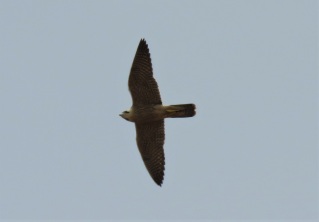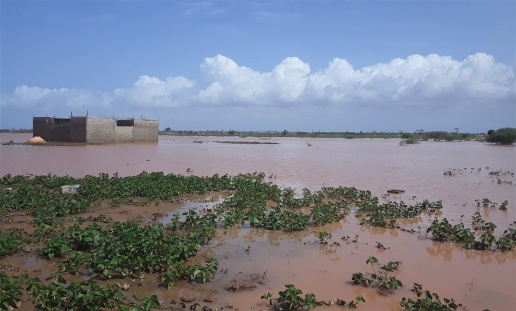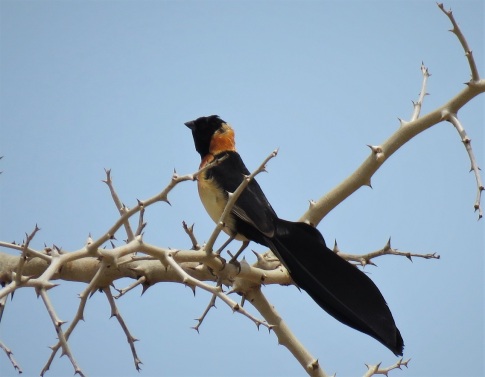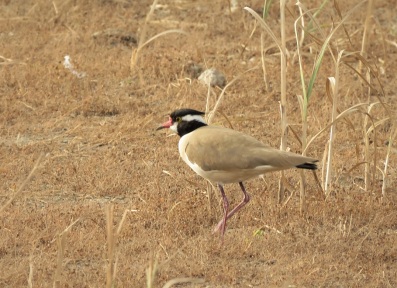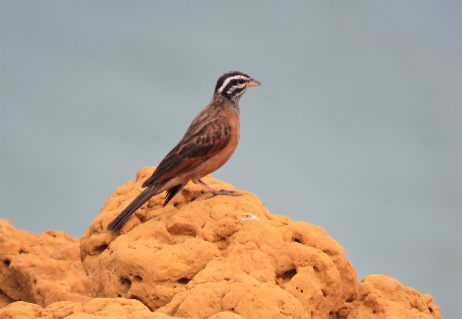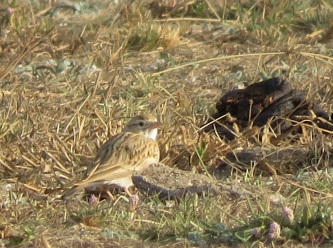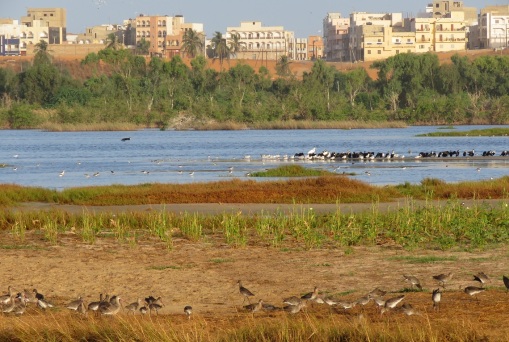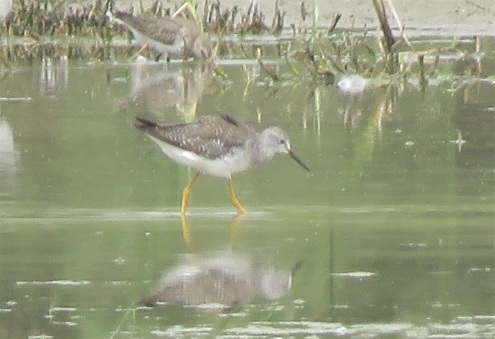Wet season visitors, Popenguine & co.
Every year during the wet season, the Sahel undergoes an impressive transformation, the landscape turning all lush green in the space of just a few weeks. Four visits to the northern Petite Côte area in just as many weeks were a nice opportunity to see this extremely rapid transition from ultra-dry to completely soaked terrain. And with it of course the associated changes in bird life.
On our first excursion to Popenguine mid-August, shortly after the onset of the first few rains, the reserve was still bone dry, only the baobabs being all green & leafy while grasses has only just begun to sprout.
Exactly one month later, this is what the same area looked like (the same baobab tree can be seen in both pictures):
Impressive, right? It never ceases to amaze me how fast everything grows here once the rains arrive!
For now, back to mid-August when all was dry, and when the highlights of our visit were a juvenile Great Spotted Cuckoo (locally hatched?)…
… a female Standard-winged Nightjar (on transit, looking for greener pastures? August is breeding season here for the species…)…
… and finally this juvenile Peregrine Falcon circling briefly above the cliffs before disappearing towards the village – an early record here, though perhaps not that surprising given that the species breeds early in the Mediterranean, even if the pair that winters in Dakar every year typically shows up around mid-October only.
Fast-forward ten days, after copious showers in the preceding days, and the lagoons of the region were now completely filled – in particular the Yene lagoon which I’ve never seen this high:
Few waterbirds were around but this will surely change in coming weeks; a Knob-billed Duck amongst the White-faced Whistling Ducks was the most notable species here (Canard à bosse, Dendrocygne veuf). Should be interesting to see how the birdlife evolves here in the next few months, and what species will show up this year (last year with the lack of rains the site was pretty disappointing, should be far more interesting this year!!).
A stroll on one of the hills above Toubab Dialaw produced several Savile’s Bustards and Singing Bush Larks, while Mottled Spinetails were flying above the small escarpment… Klaas’s and Diederik Cuckoos were heard near the village (Outarde de Savile, Alouette chanteuse, Martinet d’Ussher, Coucous de Klaas et didric).
The bustards were particularly vocal and obviously occur in good densities here, with at least 4-5 birds responding to one another. Recording here on xeno-canto; picture of habitat below. This rather sought-after Sahel special is clearly easy to find here, even if rather disturbed habitat, particularly during the rains but they may sing – albeit the shorter version of their song, and less regularly – throughout the dry season as well. They’re often difficult to spot and even a careful approach to a singing bird will usually result in just a brief glimpse, a bird flushed from low bushes, or no sighting at all… Senegal and to a lesser extent The Gambia currently remain pretty much the only easily accessible countries to find this species.
A male Sahel Paradise Whydah in full breeding plumage was encountered along the track leading to Diass:
Back to Popenguine on Sept. 8th, this time round for a very enjoyable bike tour through the bush between the villages of Popenguine, Ndayene and Toubab Dialaw (with Teranga Bike Adventure, highly recommended!) which provided a different kind of birding experience. Again Savile’s Bustard and Singing Bush Larks which are both very vocal at the moment, a Black-headed Lapwing breeding record (adult with chick), a Green Sandpiper flushed from a small pool along one of the tracks, a few Gull-billed Terns feeding over moist grassland, a Broad-billed Roller, Yellow-billed Oxpecker feeding on a donkey, a Gosling’s Bunting, and so on (Outarde de Savile, Alouette chanteuse, Vanneau à tête noire, Chevalier culblanc, Sterne hansel, Rolle violet, Piqueboeuf, Bruant d’Alexander).
Last Sunday, Popenguine nature reserve again: the usual suspects such as Rufous-tailed Scrub Robin (the resident ssp. minor, “African Scrub Robin”), Stone Partridge, Helmeted Guineafowl, Senegal Batis, several Sahel Paradise Whydahs including males in display flight and a few females, one of which was clearly interested in a pair of Green-winged Pytilias which is the host species of this brood parasite (Agrobate roux, Poulette de roche, Pintade de Numidie, Pririt du Senegal, Veuve a collier d’or, Beaumarquet melba). Woodland Kingfisher and Klaas’s Cuckoo had joined the ranks of the intra-African migrants that move north with the rains and that occur in Popenguine (Martin-chasseur du Sénégal, Coucou de Klaas).
Several Gosling’s Buntings were singing at the top of the Cap de Naze cliffs, with one bird posing quite nicely at short range:
Migrant songbirds have now started to arrive from Europe: at least three Sand Martins were flying overhead, clearly heading south, when I arrived by the pond which by now is completely filled with water; I heard a Tree Pipit, saw 4-5 migrating Barn Swallows, while the acacias and bushes held a few Melodious Warblers, Willow Warblers, a Common Whitethroat, and even a fine Nightingale. (Hirondelles de rivage et rustique, Pipit des arbres, Hippolais polyglotte, Pouillot fitis, Fauvette grisette, Rossignol philomèle).
The Popenguine eBird checklists along with other recent records from the area – including a surprising African Crake seen by Miguel – can be found here.
Plenty more to come!
And we’re off to a good start… with a new species for Senegal

New Year, New Birds! Apparently I found another new species to Senegal – needless to say that this resulted in a rather successful day out birding. Which left me wondering, rather pointlessly, how many country firsts have been found on the first day of the year.
Lac Rose
So I first went to Lac Rose, and more specifically the steppe to the NE of the lake as this area had produced a lot of good birds last winter, including three or even four Buff-breasted Sandpipers. I was keen to go back and see if any of the “specials” were around again this winter. One of the first birds I found in the short grass was Greater Short-toed Lark, so things were off to a good start.
As I started walking on the far end of the steppe, I found a very pale wheatear: a textbook Isabelline Wheatear, just like last year in January.
The same area held three Tawny Pipits and a few other birds, though not the hoped-for Temminck’s Coursers.
Towards the end of my visit I came across this Southern Grey Shrike – cool bird, but a bit too flighty to allow for decent pictures.
Also around were several Kittlitz’s Plovers (+ Common Ringed and Kentish on the lake shores), at least four Quailfinches thus confirming the species’ presence in the Niayes IBA, a Black-headed Heron, Vieillot’s Barbet dueting in the distance, and so on.
Yene
Next up: the Yène-Tode lagoon. While on my previous visit, barely two weeks earlier (17/12), there was still a good amount of water, by now the lake has all but dried up: just a little trickle here and a small pool there, with just a handful of Black-winged Stilts, Spur-winged Lapwings, a lone Knot, Common Sandpiper and a few other waders. With all the waterbirds gone, I didn’t think I’d see much on this visit, but was soon proved to be very wrong!
Shortly after getting out the car, I located a small flock of Yellow Wagtails feeding on a green patch in what used to be the lagoon just a few weeks earlier. A pipit amidst the wagtails was either going to be a Tree or (more likely) a Red-throated Pipit, so I got the bird in the scope… and was a bit puzzled at first that it didn’t fit either species?! As I approached, it flew off and called a few times, confirming my suspicion: a Meadow Pipit!! It landed a hundred meters or so further in more dense vegetation. I knew this was a good species for the country and wanted to get better views and maybe even a few pictures (I didn’t quite realise it had never been confirmed in Senegal before!), so I went after it, flushed it and again heard the diagnostic hurried hiist-ist-ist-ist flight call. It returned to the original spot, and this time round I got really good views plus a few record shots:
Note the dense streaking on a pale buffy background with streaks clotting together on middle of breast, general lack of warm tones (as would be the case for Tree Pipit), fine bill with diffuse yellowish base, absence of clear pale lines on the mantle (as in Red-throated), the “gentle” expression with fairly pale lores, an indistinct supercilium and narrow-ish submoustachial (what a word!) stripe. The rump was clearly unstreaked (thus ruling out Red-throated Pipit) and while I didn’t manage any good pictures of the hind toe, it did appear quite long and pictures show it to be only moderately curved (ruling out Tree Pipit). These pipits are no easy birds to identify on plumage, but luckily the call is so typical and unlike any other pipit that it allowed for a safe ID while I was watching the bird, and I was lucky to get a few decent shots. A few people have asked me to provide more pictures, so here they are – all are originals without any editing except for cropping.
This bird was obviously in a fresh plumage, and can be aged as a first-winter bird based on the shape and colour of the median coverts: the ‘tooth’ on the dark centre with a clear white tip (Svensson 1992) is quite visible in the pictures.
Meadow Pipit is of course a common species throughout much of Europe, be it as a breeding bird or on passage or as a winter visitor. Its non-breeding range covers western Europe and most of the Mediterranean Basin, extending along the Atlantic coast down to the Canary Islands and Morocco. In Mauritania it is considered to be scarce but regular, reaching as far as the Senegal river delta, more or less as shown on the map below (borrowed from xeno-canto). Surely it must occur at least irregularly in northern Senegal, given its status in nearby Mauritania?

While relocating the Meadow Pipit, I also flushed no less than eight Red-throated Pipits as well as three Common Quails. Two Collared Pratincoles were hanging out by the last puddles; the Marsh Harriers and most of the Ospreys are now gone, but there were still at least two Short-toed Eagles in the area, with another two along the track back to Rufisque. Two Mosque Swallow were also around, while two Zebra Waxbills were rather unexpected, given that they’re not supposed to occur in the Dakar region (see last year’s post on the sighting of a group at Technopole). Tawny Pipit was another addition to the site’s ever-growing list.
Technopole
Following a very successful morning yesterday at Technopole (Short-eared Owl! Iberian Chiffchaff! Jack Snipe!) I stopped by to have a closer look at the numerous waders, given that yesterday I’d forgotten my telescope at home… Nothing out of the ordinary to report today, just tons of waders, gulls (incl. two Mediterranean Gulls) and lots of Caspian Terns (+150, and now also 27 Greater Flamingos (nine were present yesterday). And I relocated the Iberian Chiffchaff quite easily as it’s singing regularly, and tends to keep to a single bush – more on this in another post.
Oh and happy new year!
bram
Yène 17/12: a rare duck, more waders & migrants

And Yène delivers again!
I went back to our little hotspot on Sunday morning to see what new there was to be found – and whether I could relocate three vagrant ducks that Miguel and colleagues spotted here the previous weekend (my first proper Sengalese twitch!). The lagoon is quite literally shrinking by the day at the moment, so not very much water is left by now – meaning that all waders and other remaining water birds were fairly concentrated in a small-ish area, not all of which is visible from the main viewpoints.
There were tons of waders so it took some time to go through them and count or estimate each species, resulting in the following totals:
- A few hundred Black-winged Stilts (2-300?), still five Avocets
- More than 320 Common Ringed Plovers, again at least two Little Ringed Plovers, but also a couple of Kentish and at least 39 Kittlitz’s Plovers; also several Grey Plovers
- At least 70 Marsh Sandpipers was a pretty high count, even for Senegalese standards (I actually can’t remember ever seeing so many – at one point, about 50 birds were feeding in a single group). Unusually, Marsh Sandpiper was actually the most abundant Tringa wader. Technopole also has more than usual at the moment. There were about 30 Wood Sandpipers, and a handful each of Greenshanks, Redshanks, and Green Sandpipers.
- About 60 Ruff scattered throughout
- 200 Sanderling, 120 Little Stints, ca. 30 Dunlin, one Curlew Sandpiper
- One Turnstone and Bar-tailed Godwit each
- Three Common Snipes
The Pintails, Garganeys, Shovelers and even the White-faced Whistling Ducks seem to have left as the lagoon is probably too shallow now. Instead there are now three Common Shelducks! I didn’t see them at first, but after about half an hour of sifting through the waders, they were suddenly there, actively feeding on the opposite end of the lagoon and seemingly feeling quite at home here! Maybe they’ll end up staying for a few more days or weeks, until the lagoon dries up.
Not a species I thought I would ever see here: despite its name, it’s definitely not common in Senegal! With only six published records it should be considered a real vagrant to the country. The regular winter range of Tadorna tadorna extends along the Moroccan coast, with very small numbers reaching as far south as Mauritania, though apparently the species remains pretty rare even in the Banc d’Arguin NP. Olivier Girard very conveniently summarised the status of the species in West Africa, in a short paper published in the African Bird Club Bulletin in 2009¹. In his overview, he lists 28 records, almost half of which are from Mauritania, and just five from Senegal. One was apparently overlooked despite being published in the well-known “Annotated check-list of birds occurring at the PNOD, 1984-1994” by Rodwell and colleagues, while the location of another record is incorrect.
As far as we know, no other records have been published nor have any been reported to the ABC, on eBird, or on observado.org since Girard’s summary. As such, these should be all previous Shelduck records for Senegal:
- Seven, Delta du Senegal, 27/12/73 (Morel & Morel)
- Two immatures at Djoudj NP, 21/1/74 (Morel & Morel)
- Two on 12-28/2/90 in the Djoudj NP (M. Fouquet in Rodwell et al. 1996)
- 15 in the Djoudj NP, January 1996 (Yesou et al. 1996)
- One in Djoudj NP, Jan. 1997 (Triplet et al. 1997)
- Two on 5/1/97 at Yène-Todé lagoon (= in Dakar region and not “Siné-Saloum” as incorrectly stated by Girard.
And so now, more than 20 years later, we have three first-year birds from 9 to 17/12/17 at Yène-Todé, again! (see also note below for two more records in early 2018)
It’s intriguing that there are so many more old records, given that observer coverage surely must have improved in the last 20-30 years – and that mid-winter waterbird counts are systematically conducted in the Djoudj and most other large wetlands (I really ought to get access to the database with past counts, as there don’t seem to be any published reports available?). What’s more, Shelducks have been on the increase in many parts of their Western European range, so one would logically expect more birds to show up in this part of the world. Maybe milder winters push fewer birds to the southern end of their range, or the populations that have increased are more sedentary than others? In better-watched Mauritania, at least during the first decade of the 21st century, there are just six records listed since 2000, one of which was near the border with Senegal in the Aftout es Saheli in January 2007, while elsewhere in the delta, Shelducks were seen in December 1995 and three times between Nov. ’98 and Jan. ’99: not much!! Three records each are known from Mali, Ghana and Niger, with one from Guinea (January 2006).
Addendum 2/2/18: eight birds were seen at the Grand Lac in the Djoudj NP on 17/1 (C. Ruchet, Y. Menétrey, I. Ndiaye), quite possibly the same group that was sighted on 30/12/17 in the Diawling on the other side of the border. The first for Technopole was on 18-19/2/18 (E. Regala Ruiz, J. Ruiz, BP, G. Caucal, E. Rogeau), confirming the small influx that occurred during the 17/18 winter.
So what else was about? Glossy Ibis is still present (at least 3 ind.), and now no less than 28 European Spoonbills, most of which arrived from the NW and landed in the central part of the lagoon. As usual there were several Osprey and Marsh Harriers, plus an immature Short-toed Eagle hunting around the lake’s edge, a pair of Red-necked Falcons roosting on a tree, and a Common Kestrel (and on 9/12, Miguel & co. had a fine Barbary Falcon).
The flock of gulls and terns held the usual Caspian, Royal, Sandwich and Common Terns, but just a few Audouin’s Gulls, LBBGs, Slender-billed, Grey-headed and Black-headed Gulls this time round.
Just like on my last visit, Red-throated Pipit was present on the lagoon’s edge: I first heard its sharp pssiiiii call in the SE corner, then briefly saw (and heard) what was probably a second bird, a few hundred meters further. Two Tree Pipits were also present.
Other migrant songbirds included Yellow Wagtails of course, plus Northern Wheatear, Subalpine Warbler, Common Whitethroat, Sedge Warbler, and Woodchat Shrike.
All in all, another very enjoyable morning out at Yène!
Technopole update
A Technopole pit-stop on the way back to Dakar resulted in yet more waders, with still some 300 Black-tailed Godwits around (just one ring could be read, as most birds were feeding or resting in deeper water) and lots of other waders. On my previous visit, we managed to read six rings, mostly in this flock of BTGs feeding on land:
The water levels are already quite low and I’d reckon that they are about the same as in April 2017: let’s hope that the site doesn’t completely dry up by the end of the dry season!!
More of a surprise was an adult African Spoonbill (also two Europeans) resting on one of the islets, its deep crimson face just about visible. Surprising, because it’s not a frequent visitor to Technopole, and so far my only records have been in April and May.
A Common Moorhen with a very young chick, confirming local breeding of the species. Other than that, lots of Lesser Black-backed Gulls (+300), a few Audouin’s Gulls, a White-winged Tern feeding among the Black Terns, at least two Knot, lots of Ruff, etc. An adult male Peregrine Falcon may be the same bird that I see almost daily on the Diarama hotel.
¹ Girard, O. 2009. Le Tadorne de Belon Tadorna tadorna en Afrique de l’Ouest. Bull ABC 16: 180-183.
La lagune de Yenne-Tode

Comme je le disais déjà dans l’article sur le Chevalier à pattes jaunes de la semaine dernière, la lagune de Yenne est en ce moment un site incroyablement riche en oiseaux. Au point où l’on y trouve actuellement plus d’oiseaux qu’au Technopole¹ – autant dire que ça cartonne!
Lorsque le site est rempli d’eau comme c’est le cas cette année, on trouve là une impressionnante diversité d’oiseaux. Rien qu’en quatre visites en l’espace d’autant de semaines, nous avons pu détecter la présence de pas moins de 144 espèces… Il ne doit pas y avoir beaucoup de sites dans la région de Dakar où il est possible de voir plus de 100 espèces en une matinée! Autant dire que c’est notre site favori du moment.
Il semblerait cependant que la situation soit très variable d’une année à une autre, comme en témoignent les deux articles de Paul dans lesquels il est question de cette zone: lire ici (octobre 2011) et là (octobre 2013), deux visites lorsque le site était largement en assec. Quoiqu’il en soit, cette lagune mérite bien d’être protégée et préservée, alors qu’actuellement elle ne bénéficie d’aucun statut de protection… ce qui vaut bien malheureusement pour la plupart des zones humides autour de la capitale: Technopole, les lacs de Malika et Mbeubeusse, les niayes du secteur Lac Rose – Kayar – Tanma, etc. A Yenne, les travaux routiers ont visiblement changé la dynamique hydraulique, et les premiers signes annonciateurs d’extension de la zone d’habitation à venir sont déjà là, y compris DANS une ancienne partie de la lagune.
Pour s’y rendre, voir Google Maps. A noter que le nom du site peut aussi s’écrire comme Yène Tode, Yene-Todé, et autres variantes. La visite pourrait se faire en combinaison avec une virée du côté de Popenguine ou de Toubab Dialaw, voire avec le Lac Rose qui n’est pas très loin, mais il faut prévoir 2-3 heures au minimum.
Dans cette vaste zone humide on trouve en ce moment des canards en nombre, avec plus d’un millier d’individus de six espèces en tout lors de nos quatre visites ces dernières semaines: Dendrocygne veuf (plus de 500 le 18/11!! Et deux canetons âgés de deux semaines le 21/10, ML), +90 Canards souchets, +420 Sarcelles d’été, même des Canards pilets (env. 20 le 13/11). Le 29/10, Miguel a eu la chance de trouver une famille (locale?) de Canards à bosse et, surtout, une Oie-armée de Gambie, palmipède visiblement rare dans la région dakaroise. Mais ce sont donc surtout les canards européens dont les effectifs sont impressionants: à mettre en relation avec le manque d’eau sur d’autres zones humides, comme le lac Tanma mais surtout le Bas-Delta du Sénégal, qui connaîtrait un déficit pluviométrique important cette année?
Les limicoles aussi profitent de cette grosse mare temporaire: plus d’une douzaine de Jacanas à poitrine dorée se nourrissant sur les nénuphars (y compris deux jeunes probablement nés localement), bien entendu les éternels Vanneaux éperonnés mais aussi à tete noire, ces derniers dans les parties plus sèches de la zone. Samedi dernier il y avait aussi cinq Avocettes, et de nombreuses Echasses blanches bien sûr, tout comme les Grands Gravelots mais aussi pour une fois des Petits Gravelots ainsi que quelques dizaines de pâtres, tout comme un Gravelot à collier interrompu vu samedi dernier. Les vasières abritent aussi pas mal de Pluviers argentés, quelques Barges à queue noire et une rousse, 5 Courlis corlieux le 29/10, des Becasseaux sanderlings, minutes, variables, cocorlis, et même maubèches… Cette dernière espèce semble d’ailleurs plus fréquente que d’habitude cet automne. Les sympathiques Tournepierres à collier se baladent entre tout ce beau monde, cherchant un caillou ou un coquillage à retourner… tandis que Chevaliers stagnatiles, aboyeurs, gambettes, sylvains, culblancs, et guignettes fréquentent les secteurs légèrement plus profonds du plan d’eau principal, tout comme plus d’une centaine de Combattants variés. Quelques Bécassines des marais se cachent dans la vegetation, tout comme au moins trois Rhynchées peintes.
Soit pas moins de 29 (!) espèces de limicoles pour l’instant, et je suis sûr qu’il nous en manque encore des réguliers, comme l’Huîtrier pie ou le Vanneau caronculé.
Du côté des laridés et des sternes, on trouve un peu de tout: quelques Mouettes à tête grise et surtout des rieuses et des Goélands raillers, parmi lesquels samedi dernier se trouvaient au moins quatre Mouettes mélanocéphales; le Goéland d’Audouin tout comme quelques Goélands bruns doivent être réguliers ici. Plusieurs centaines de Sternes caugeks semblent régulièrement utiliser le site comme reposoir, accompagnées par quelques royales, voyageuses, caspiennes, hansels, naines et pierregarins en petit nombre. Les Guifettes noires étaient assez nombreuses fin octobre surtout, lorsque Miguel a aussi pu identifier une leucoptère.

Caspian & Sandwich Tern, Slender-billed & Mediterranean Gull / Sterne caspienne & caugek, Goélands railleurs, Mouette mélanocéphale
Les grands échassiers ne sont pas en reste: hérons et aigrettes de toutes sortes bien sûr, dont les Herons pourpré et mélanocéphale et le Crabier chevelu, et même un Blongios de Stürm (Least Bittern!), à ma connaissance la première obs dakaroise. C’est Miguel qui a eu la chance de se retrouver nez à nez (à bec?) avec ce minuscule héron, un jeune individu, juste le temps de faire une photo témoin. Samedi dernier il y avait également au moins trois Ibis falcinelles – mes premiers de l’automne – et 1-2 Spatules blanches sont observées lors de nos deux dernières visites.
Parmi les autres oiseaux d’eau, citons les deux espèces de pélican, la Talève d’Afrique (une le 29/10), même la Foulque macroule (deux les 21 et 29/10, ML) et le Grèbe castagneux qui est nicheur ici. Et il doit bien de temps à autre se cacher une marouette dans la végétation palustre!
Il y a aussi les Balbuzards bien sûr, mais aussi plusieurs Busards des roseaux, un Circaète Jean-le-Blanc (13 & 18/11), Shikra (29/10), et samedi dernier aussi ce que nous avons identifié comme un jeune Circaète de Beaudouin, un Faucon lanier, et un Faucon chicquera.
Les passereaux migrateurs paléarctiques abondent en ce moment, que ce soit dans les acacias et tamaris (Rougequeue à front blanc, Fauvettes passerinette et grisette, Hypolaïs polyglotte, Pouillots véloce et fitis) ou dans les scirpes et les abords du plan d’eau (Phragmite des joncs, Bergeronnettes grise et printanière, Pipit des arbres, Traquet motteux). Des visites régulières lors de l’hiver nordique révèleront sans doute d’autres passereaux encore.
Parmi les locaux, citons entre autres l’Alouette chanteuse, le Moinellette à oreillons blancs, la Veuve à collier d’or ou encore l’Astrild cendré. Le Cou-coupé semble relativement commun, y compris dans le village même. Deux Pipits à dos uni sont identifiés par Miguel le 29/10. Et aussi, bien curieusement, le Bruant d’Alexander! Le 18/11 nous avons eu la surprise de voir un jeune oiseau posé au bord de la lagune, bien loin de ses milieux de prédilection rocailleux. Sans doute un individu en dispersion depuis les collines de Toubab Dialaw (où il pourrait nicher) ou les falaises de Popenguine.
Enfin, une mention speciale pour le Coucou-geai et le Martinet pâle vus le 29/10, et cette Tourterelle pleureuse le 18/11.
¹ Et justement au Technopole, quoi de neuf me demanderez-vous? Rien de bien exceptionnel lors de mes trois dernières visites! Tout de même un ajout à la liste: le Souimanga pygmée vu le 8/11 près du Club House. Des ornithos de passage y ont récemment noté la Rhynchée peinte que je n’ai pas vue depuis un bon moment ici, et aussi et surtout le Faucon de Cuvier qui ne figurait pas encore sur la liste. Le niveau d’eau est déjà assez bas, ce qui fait que les conditions sont bonnes pour bon nombre de limicoles (dont 10 Maubèches le 19/11) et de laridés (première Mouette mélanocéphale de la saison le 19/11) mais aussi pour les canards qui sont présents en nombres plus importants que ces trois dernières années: jusqu’à 45 Sarcelles d’été, 90 Canards souchets (premiers le 8/10), et même cinq Pilets dimanche dernier. Par contre, ça risque de s’assécher rapidement au cours des prochains mois, donc je doute qu’il restera beaucoup d’eau au printemps prochain… à suivre.
Another Lesser Yellowlegs (Chevalier à pattes jaunes)
Quick note today to report on the first Nearctic vagrant of the season: a Lesser Yellowlegs, seen yesterday at the Yenne-Todé lagoon.
After a very productive few days at Guereo, Bandia, and Popenguine – more on this later – I made my way back to Dakar via Yenne, the first village on the north end of the Petite Cote. I’ve known for a while that there’s a good lagoon here, but never visited at the right time of the year. A few weeks ago, Miguel had a great morning at the site (105 species including Dwarf Bittern, Spur-winged Goose, lots of Garganey), which prompted me to go see what’s about at the moment… Expectations were high, and I wasn’t disappointed: hundreds of ducks, many herons, a few gulls and quite a few terns, and most of all an incredible diversity of waders: 26 species!! Almost all regular migrant waders plus several of the local species were noted, some of which in decent numbers (e.g. nearly 30 Marsh Sandpipers, a few hundred Little Stints and Common Ringed Plovers, +120 Ruff). The site, which apparently is called the Niayetir lagoon, is easily accessible from different sides, mainly along the road coming from Toubab Dialaw but also from the village itself.
After I visited the main wetland just north of the road to Yenne, I stopped at the lagoon just behind the village, along the road back to Bargny. While scanning the numerous waders, I noticed a medium-sized wader with bright yellow legs: Yellowlegs!! It was actively feeding amidst the other waders, close enough to get good views through the telescope, but just a bit too far for decent photos…
Its flashy yellow legs made it stand out against all other waders here (bird names don’t need to be complicated!). Identification as Lesser Yellowlegs was pretty straightforward thanks to its relatively fine bill about equal to the length of the head, as well as overall structure. The straight all-dark bill of medium length and fairly uniform brown-grey breast and upperparts, as well as the smaller size and more slender appearance, distinguish it from the much rarer Greater Yellowlegs (which has never been recorded in Senegal). Moreover, the size of this bird was roughly the same as Marsh Sandpiper with which it was seen side by side, just slightly bulkier and with a marginally heavier bill. The Marsh Sandpiper is just about visible on the picture below:
A long-distant migrant, Lesser Yellowlegs mainly breeds throughout Canada and Alaska, and winters in a variety of wetland habitats from coastal areas of the US all the way down to the southernmost tip of South America (Tierra del Fuego). It is a rare vagrant to West Africa, with only six previous records in Senegal that I’m aware of, all of single birds between August and March:
- 6-7/1/91 at Hann, Dakar, “Feeding with Ruff, Wood Sandpipers and Marsh Sandpipers” (Sauvage & Rodwell)
- 3/3/07 in the Djoudj NP (Julien Piette)
- 18/3/13 at the Kaolack saltpans (Simon Cavaillès)
- 3-12/1/15 at Keur Samba Han near Kaolack (Simon Cavaillès)
- 15/8/15 at Technopole (BP)
- 17/1/16 at Technopole (BP, Boris Droz, Jérôme Gremaud)
As such, it’s the second most frequently noted American wader in Senegal together with Buff-breasted Sandpiper. Only American Golden Plover has been seen more often, with 10 records so far; and if last winter’s trend continues then Buff-breasted Sandpiper will soon overtake Tringa flavipes (no less than four records of six birds were obtained between mid-November 2016 and early January 2017!)
Elsewhere in Africa, Lesser Yellowlegs has mostly been noted on the Cape Verde islands, and there are a handful of records from Mauritania (22/3/04 and 6/2/14), The Gambia (January 1976, 13/10/08; possibly others), Ghana (at least two, incl. on 16/10/08), and Nigeria (Feb.-March 1969). Further north it’s been reported from the Canary Islands, Madeira, Morocco, and Tunisia. There are also a few records from South Africa (including one on Tristan da Cunha island in the South Atlantic), Namibia, and even Botswana.
I’ll try to go back over the weekend and see if it’s still around – and why not find another Yank this time!

